Cult is the "care" owed to deities and temples, shrines, or churches. Cult is embodied in ritual and ceremony. Its present or former presence is made concrete in temples, shrines and churches, and cult images, including cult images and votive offerings at votive sites.

The Chiesa del Santissimo Redentore, commonly known as Il Redentore, is a 16th-century Roman Catholic church located on Giudecca (island) in the sestiere of Dorsoduro, in the city of Venice, Italy.

Genuflection or genuflexion is the act of bending a knee to the ground, as distinguished from kneeling which more strictly involves both knees. From early times, it has been a gesture of deep respect for a superior. Today, the gesture is common in the Christian religious practices of the Anglican Church, Lutheran Church, Roman Catholic Church, and Western Rite Orthodox Church. The Latin word genuflectio, from which the English word is derived, originally meant kneeling with both knees rather than the rapid dropping to one knee and immediately rising that became customary in Western Europe in the Middle Ages. It is often referred to as "going down on one knee" or "bowing the knee". In Western culture, one genuflects on the left knee to a human dignitary, whether ecclesiastical or civil, while, in Christian churches and chapels, one genuflects on the right knee when the Sacrament is not exposed but in a tabernacle or veiled.

A votive candle or prayer candle is a small candle, typically white or beeswax yellow, intended to be burnt as a votive offering in an act of Christian prayer, especially within the Anglican, Lutheran, and Roman Catholic Christian denominations, among others. In Christianity, votive candles are commonplace in many churches, as well as home altars, and symbolize the "prayers the worshipper is offering for him or herself, or for other people." The size of a votive candle is often two inches tall by one and a half inches diameter, although other votive candles can be significantly taller and wider. In other religions, such as Hinduism and Buddhism, similar offerings exist, which include diyas and butter lamps.
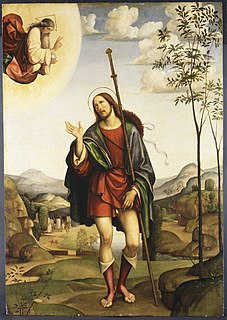
Roch or Rocco (lived c. 1348 – 15/16 August 1376/79 is a Catholic saint, a confessor whose death is commemorated on 16 August and 9 September in Italy; he is especially invoked against the plague. He may also be called Rock in English, and has the designation of Rollox in Glasgow, Scotland, said to be a corruption of Roch's Loch, which referred to a small loch once near a chapel dedicated to Roch in 1506.

Recceswinth was the Visigothic King of Hispania, and Septimania in 649–672. He ruled jointly with his father Chindaswinth until his father's death in 653.

A retablo is a devotional painting, especially a small popular or folk art one using iconography derived from traditional Catholic church art. More generally retablo is also the Spanish term for a retable or reredos above an altar, whether a large altarpiece painting or an elaborate wooden structure with sculptures. Typically this includes painting, sculpture or a combination of the two, and an elaborate framework enclosing it. The Latin etymology of the Spanish word means "board behind". Aside from being found behind the altar, "similar ornamental structures are built and carved over facades and doorways", called overdoors.
Benedicamus Domino is a closing salutation that was formerly used in the Latin Mass instead of the Ite, missa est in Masses which lack the Gloria. The response, said afterwards, is Deo gratias. It is also sung as a versicle at the end of all Offices.
As currently used, the terms Chapter Mass and Conventual Mass refer to the Mass celebrated by and for a community of priests or for a community of priests and brothers or sisters.
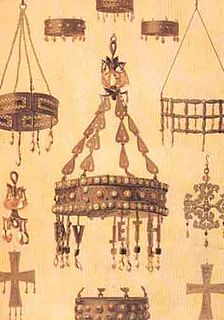
The Treasure of Guarrazar, Guadamur, Province of Toledo, Castile-La Mancha, Spain, is an archeological find composed of twenty-six votive crowns and gold crosses that had originally been offered to the Roman Catholic Church by the Kings of the Visigoths in the seventh century in Hispania, as a gesture of the orthodoxy of their faith and their submission to the ecclesiastical hierarchy. The most valuable of all is the votive crown of king Recceswinth with its blue sapphires from Sri Lanka and pendilia. Though the treasure is now divided and much has disappeared, it represents the best surviving group of Early Medieval Christian votive offerings.

St. Wenceslaus is a church of the Roman Catholic Archdiocese of Chicago located at 3400 North Monticello Avenue in the Avondale neighborhood of Chicago, Illinois.

The Church of Sts. Olha and Elizabeth in Lviv, Ukraine is located between the city's main rail station and the Old Town. It was originally built as the Roman Catholic Church of St. Elizabeth and today serves as the Greek Catholic Church of Sts. Olha and Elizabeth.
The Feast of the Most Precious Blood of Our Lord Jesus Christ is a feast included in the General Roman Calendar in 1849.
In the liturgy of the Catholic Church, a votive Mass is a Mass offered for a votum, a special intention.
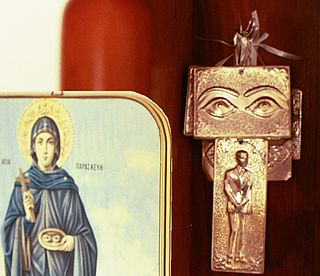
Tama are a form of votive offering or ex-voto used in the Eastern Orthodox Churches, particularly the Greek Orthodox Church. Tamata are usually small metal plaques, which may be of base or precious metal, usually with an embossed image symbolizing the subject of prayer for which the plaque is offered.

The First Friday Devotions are a set of Catholic devotions to especially recognize the Sacred Heart of Jesus, and through it offer reparations for sins. In the visions of Christ reported by Saint Margaret Mary Alacoque in the 17th century, several promises were made to those people who practiced the First Fridays Devotions, one of which included final perseverance.
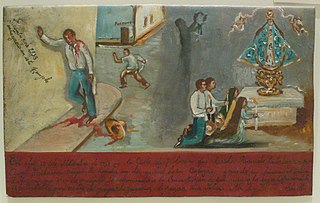
Votive paintings in Mexico go by several names in Spanish such as “ex voto,” “retablo” or “lámina,” which refer to their purpose, place often found, or material from which they are traditionally made respectively. The painting of religious images to give thanks for a miracle or favour received in this country is part of a long tradition of such in the world. The offering of such items has more immediate precedence in both the Mesoamerican and European lines of Mexican culture, but the form that most votive paintings take from the colonial period to the present was brought to Mexico by the Spanish. As in Europe, votive paintings began as static images of saints or other religious figures which were then donated to a church. Later, narrative images, telling the personal story of a miracle or favor received appeared. These paintings were first produced by the wealthy and often on canvas; however, as sheets of tin became affordable, lower classes began to have these painted on this medium. The narrative version on metal sheets is now the traditional and representative form of votive paintings, although modern works can be executed on paper or any other medium.

A votive ship, sometimes called a church ship, is a ship model displayed in a church. As a rule, votive ships are constructed and given as gifts to the church by seamen and ship builders. Votive ships are relatively common in churches in the Nordic countries Denmark, Sweden, Norway and Finland, as well as on Åland and Faroe islands, but are known also to exist in Germany, the United Kingdom and Spain.
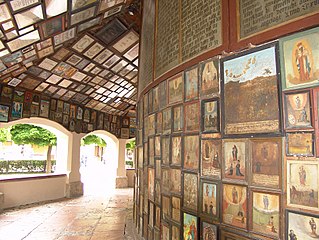
A votive offering or votive deposit is one or more objects displayed or deposited, without the intention of recovery or use, in a sacred place for religious purposes. Such items are a feature of modern and ancient societies and are generally made in order to gain favor with supernatural forces.

The Shrine of Saint Mary the Crowned of Carmel, also called Shrine of Our Lady of the Hens, is a Roman Catholic Marian shrine located in Pagani, Campania, annually hosting the feast of Our Lady of the Hens.














